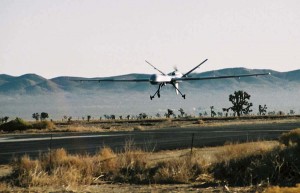 Reports from May 1 protests around the US, particularly in Seattle, may look disturbingly familiar to anyone worried about police militarization.
Reports from May 1 protests around the US, particularly in Seattle, may look disturbingly familiar to anyone worried about police militarization.
To be fair, this outlet suggests Seattle saw a contingent of aggressive marchers and rioters who were determined to provoke a response from law enforcement. Some protesters allegedly threw bottles and chunks of concrete at police who responded with pepper spray, and potentially-lethal flashbang grenades. Eight officers were injured, and 17 protesters arrested. Maybe some of those 17 deserved it.
But at least since Occupy led to middle class white kids being pepper sprayed, Tasered, and cuffed on Smartphone camera, the militarization of police has become worthy of general debate — and it must be debated. This week it was Mayday, the week before it was the heavy-handed manhunt for the Tsarnaev brothers that provoked argument over the rightness of domestic policing turning jackbooted. Less common knowledge, and harder to suss out than police brutality footage on Youtube, though, is the close ties that the Department of Homeland Security has to law enforcement militarization. This is to the tune of billions of dollars in DHS loans for tanks, surveillance, and other tech that have helped turn Officer Friendly into the riot-ready or even war-ready soldiers you see at every protest, and sometimes at your doorstep.
In March, the American Civil Liberties Union launched an investigation into this phenomenon. They’re calling the project “Towns Don’t Need Tanks.” So far they have “[f]iled over 260 public records requests with law enforcement agencies and National Guard offices to determine the extent to which federal funding and support has fueled the militarization of state and local police departments.”
It didn’t start with DHS, or fears of terrorism, however. Police have looked like soldiers — or even worked with them — since the days of Reagan. Several 1980s amendments to the post-Reconstruction 1878 Posse Commitatus Act — designed to restrict the armed forces from turning into a domestic police force, ironically enough — explicitly allow use of drug-fighting military tech by cops. Officers you see today are descended from hysteria and paranoia over narcotics, but they’ve got lots of different jobs to do now.
The Seattle protest perhaps wasn’t the poster child for outrageous police aggression against meek activists. However, it brings all the same questions about the status quo police reaction to nearly every threat. Alright, cops get to use pepper spray and flashbang grenades when they’re getting hit by bottles. But we have to ask where and when law enforcement who look like soldiers won’t be allowed such methods. SWAT and riot tactics are now the appropriate response to nonviolent protest and standing around at your own college, drug use, gambling, graffiti, and cockfighting. So why blink when anarchists in black blocs bring about police violence, too?






